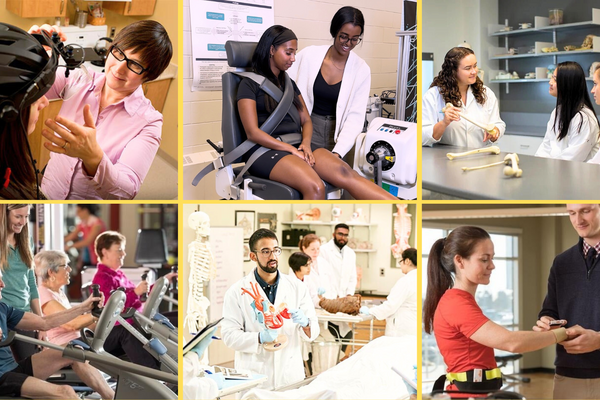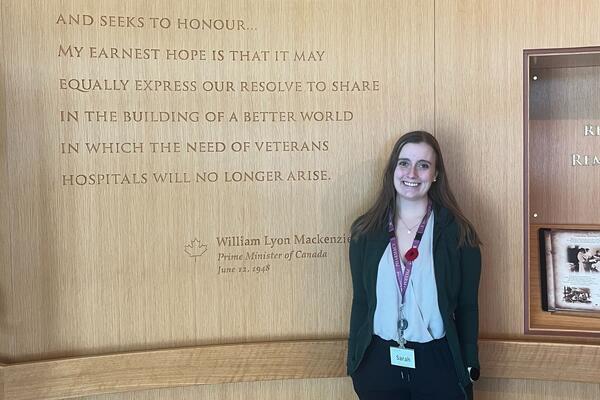
Indigenous optometry student helps bring reconciliation into focus
University of Waterloo optometry student prompts changes to standardized eye exam cards

University of Waterloo optometry student prompts changes to standardized eye exam cards
By Media RelationsIf you’ve ever had an eye exam, you’ve probably been asked to read from a card to test your near vision. The words were likely from standardized text developed in the 1960s. That text is now being changed thanks to an initiative by a University of Waterloo optometry student to advance health equity for Indigenous peoples.
Jeremiah Hyslop, a Class of 2026 student at the School of Optometry & Vision Science, is a member of the Xaxli’p First Nation of the BC Interior. Last academic year, during the first few days of his Clinical Techniques lab, he was handed a card where he read text that included phrases such as “popcorn was perfected by the American Indians” and “Indian corn is used for popping.”
The more he thought about it, the more Hyslop became concerned about the effects the commonly used card might be having.
Hyslop had long wanted to work in healthcare, in large part because he’d encountered racist attitudes as a patient and knew his relatives had too. In a class on clinical experience, which the School had recently updated to include more emphasis on cultural safety, he’d learned Indigenous peoples are the group in Canada most likely to experience negative patient-provider interactions.
“I didn’t think having a term that a lot of Indigenous people would find offensive on a piece of medical equipment would help health outcomes improve,” Hyslop said. “If a patient feels offended, they won’t trust the healthcare provider, so they might not be as forthcoming about their issues and ultimately, their eye health could be impacted.”
Hyslop spoke to his professors, Dr. Lisa Christian, associate director of clinical education, and Dr. Natalie Hutchings, associate director of academics, about the issue. Together, they contacted the card manufacturer, Precision Vision, and met with the company to discuss their concerns.
Following the initial meeting, Hyslop worked with the professors and Elder Myeengun Henry, Indigenous Knowledge Keeper with the University’s Faculty of Health, to discuss how the text could be changed while still maintaining clinician outcomes.
Hyslop consulted with elders on alternative wording that would be culturally appropriate, while Hutchings and Christian analyzed the suggestions to ensure changing the text would achieve the same results in assessing near vision.
As a result of this collaboration between the School of Optometry & Vision Science and Precision Vision, the new reading cards will have updated text that refers to “the Indigenous peoples of North America” and “flint corn.”
“We were honoured to work with the University of Waterloo on this project,” said Ed Kopidlansky, president and CEO of Precision Vision. “We pride ourselves on creating the highest-quality vision testing devices, so it’s important our products be both up to date and scientifically validated. This partnership has achieved that.”
Hyslop was excited to see the digital proof for the new card and hopes to get an order in soon for the whole of the first-year class. Students purchase their own cards, which they often end up using in their practices once they’ve graduated.
“It’s a seemingly small change, but it’s working towards reconciliation,” Hyslop said.
Hyslop also worked with the School of Optometry & Vision Science’s administration on another initiative to make Indigenous students and patients feel more welcome: the installation of a medicine wheel in the Waterloo Eye Institute patient waiting area.
The medicine wheel will be officially unveiled at 1:30 p.m. on September 29, the day before the National Day for Truth and Reconciliation. All are welcome.
Jeremiah Hyslop discusses the effort to get the wording changed on a card commonly used in vision tests and what it means for reconciliation. Listen to the interview on the Beyond the Bulletin podcast.

Read more
From optometry and pharmacy to public health and therapeutics, Waterloo alumni are powering Canada’s health care sector

Read more
Here are the people and events behind some of this year’s most compelling Waterloo stories

Read more
Waterloo pharmacy alum and Sunnybrook Health Science Centre team deliver compassionate care to those who have served in the Canadian military
The University of Waterloo acknowledges that much of our work takes place on the traditional territory of the Neutral, Anishinaabeg, and Haudenosaunee peoples. Our main campus is situated on the Haldimand Tract, the land granted to the Six Nations that includes six miles on each side of the Grand River. Our active work toward reconciliation takes place across our campuses through research, learning, teaching, and community building, and is co-ordinated within the Office of Indigenous Relations.